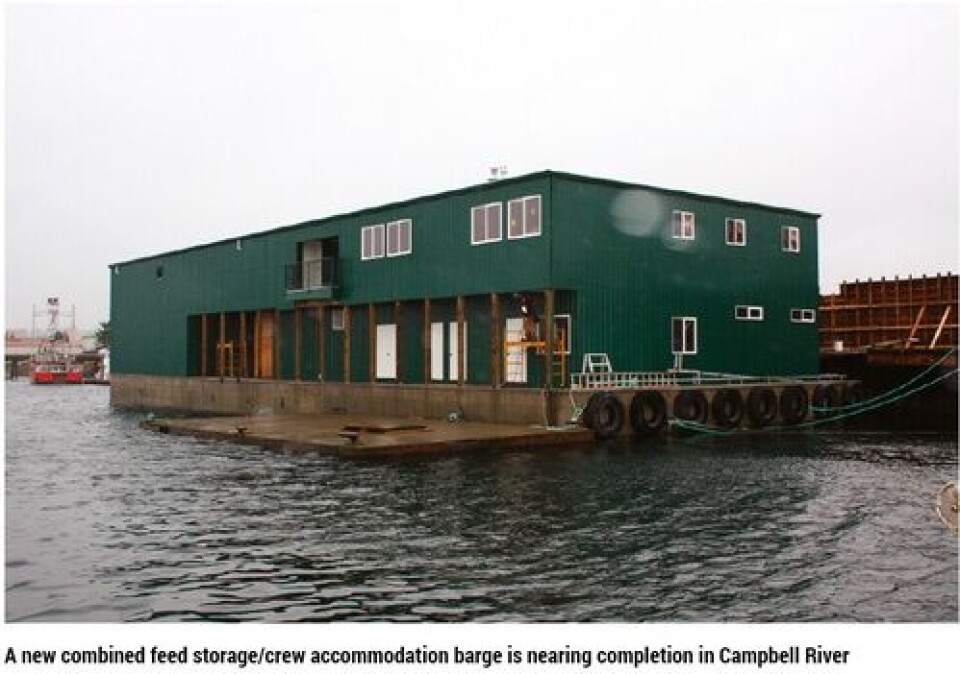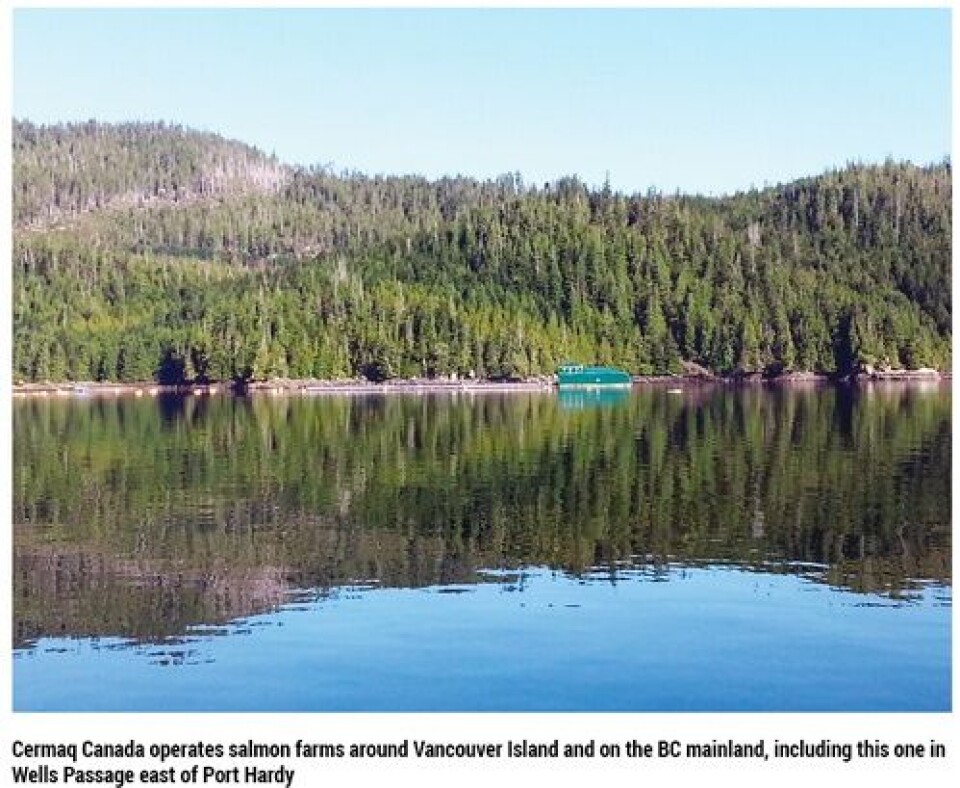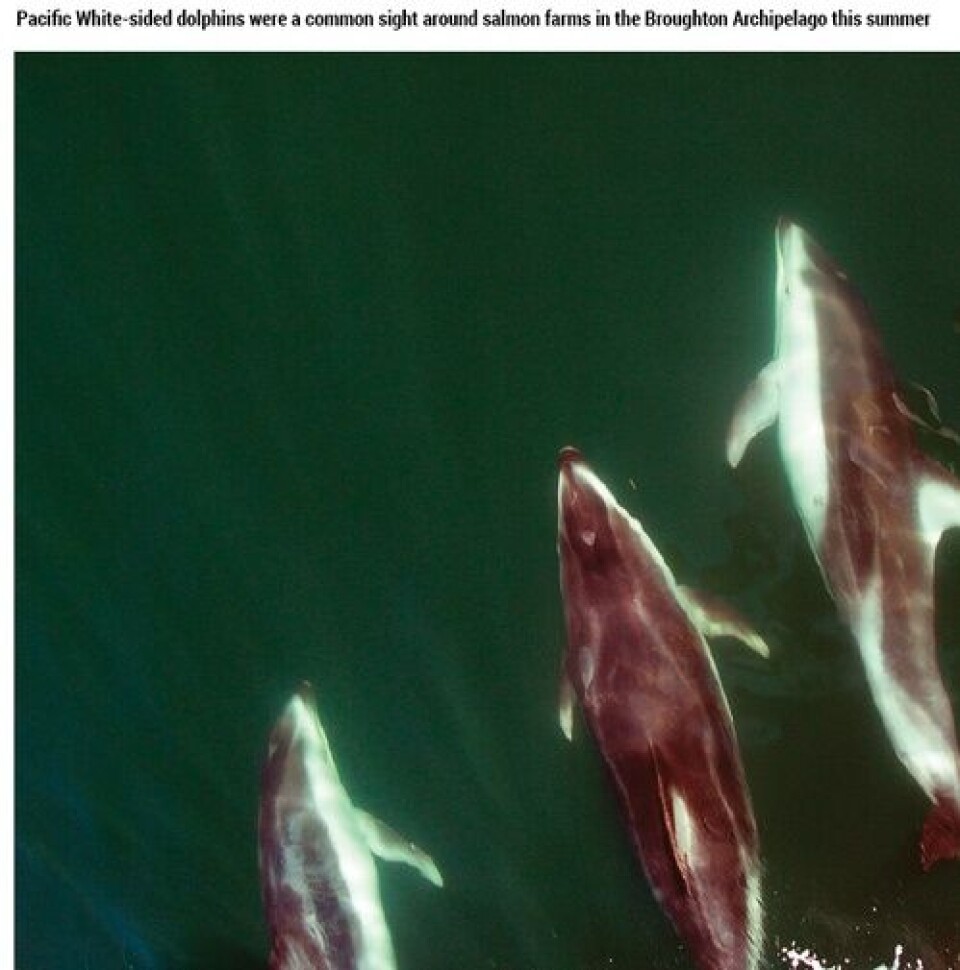Mixed Results for Norwegian Companies in British Columbia
Odd Grydeland odd@fishfarmingxpert.com

Recently released figures from the B.C. government showed an increase in the production of farmed salmon in B.C. in 2013 of about four per cent- from 78,400 tonnes in 2012 to 81,500 tonnes in 2013. But the wholesale value of those fish rose by an impressive 33.5 per cent- largely due to higher selling price- but a lower Canadian dollar has also helped. The exchange rate dropped about 7% during the year- a decline that has continued in 2014. In early January, 2013 the Canadian and US dollars were about equal in value, but today it costs about 1.14 Canadian dollars to buy one American, meaning that Canadian fish farmers- who pretty much all sell their products in US dollars- receive more money in their pockets when cashing those fish sales slips. The wholesale value of the B.C. salmon farming industry stood at CAD$ 594.5 million (~€434 million at a July 01, 1013 exchange rate) in 2013, with Atlantic salmon representing some 87% of the sales. This percentage is expected to increase, as some producers are curtailing their production of Pacific salmon. One of the reasons for companies like Grieg Seafood moving away from producing Pacific salmon is the glut of wild-caught Pacific salmon seen in some of the commercial fisheries in recent years. The average harvest of wild salmon (many of which come from enhancement hatcheries and other aquaculture facilities) has been about 17,700 tonnes in recent years (2010-2013), and this summer also saw a bumper crop, including an especially strong run of Sockeye salmon heading for the Fraser River and its tributaries. Preliminary figures show a commercial salmon catch in 2014 of an estimated 8.3 million fish- mostly Sockeye and Pink salmon (~4.0 million each). Most of these fish end up in the fresh salmon market over a short period of a few months, in direct competition with Pacific salmon from farmers who must also move their fish into the market place before the quality of the fish deteriorates too much due to the naturally-occurring sexual maturation process. Last year, over 14 million Pacific salmon were caught in B.C. Some producers of farmed Pacific salmon- like the Tofino-based Creative Salmon Company- have managed to keep prices fairly steady by selling their product to customers outside North America. About 8.3 million salmon have been caught so far in the 2014 B.C. commercial salmon fishing industry The results (Operational EBIT) during the Third Quarter of 2014 as well as for the year 2013 for the Canadian operations of the Norwegian fish farming companies were as follows, before adjustments for fair value;

Marine Harvest Canada Internationally, Marine Harvest has had a good and profitable run that continued into the third quarter of 2014. Revenues for the quarter totalled NOK 6.2 billion (~€ 753 million) compared with NOK 4.3 billion (~€ 550 million) for the same quarter in 2013. The corresponding Operational EBIT figures were NOK 912 million (~€ 110.8 million) and NOK 793 million (~€ 101.5 million), respectively (exchange rates for August 15 of the year in question used). The company had a positive EBIT during Q3, 2014 in all of its areas of operation (Norway, Scotland, Canada and Chile). In British Columbia, Marine Harvest Canada had deliberately dropped the output of smolts in earlier years, resulting in the harvesting of just over 7,000 tonnes during the quarter which was a sign of production starting to reverse the trend of reduced output. The company produced about 800 tonnes more this quarter than a year earlier. The total production from Marine Harvest’s B.C. operations this year and/or early next year will be lower than previously expected by about 1,500 tonnes due to the loss of an estimated 280,000 fish of an average weight of 4.1 Kg, according to a company release issued on September 29 this year. The fish died from an unusual exposure to a bloom of the dinoflaggelate algae Heterosigma akashiwo, which is the same species of commonly found algae that chased most of the salmon farms away from the Sunshine Coast some 25 years ago, where these algae caused massive blooms and subsequent losses of mostly Pacific salmon and Rainbow trout. The farm that was hit with this bloom is near Port Hardy on the north end of Vancouver Island, where blooms of these algae have not been common. The company’s farms had been on high alert for harmful plankton all summer, following an unusually long period with hot, sunny days which typically precedes such bloom events. “We’ve had over three months of sunny days, and have watched the plankton grow in many of our operating areas over this time,” said James Gaskill, Production Director. “Our mitigation systems, which include tarps and aeration, have worked very well in all other regions but just couldn’t overcome this extreme and rare bloom.” It remains to be seen how much the company can collect from its insurance agent in financial compensation for the loss. Like its Norwegian counterparts operating in British Columbia, Marine Harvest has ambitions about an increase in production, given the favourable outlook for the prices of farmed salmon over the next years. In its Q3 company report, Marine Harvest states that “The outlook for the salmon farming industry looks very favourable for the medium and long term due to modest supply growth. Under these circumstances, Marine Harvest can gradually benefit from unutilized capacity in Chile, Scotland and Canada”. The world production of Farmed Atlantic salmon is expected to increase by about 8% this year and by 3% in 2015. In 2013, Atlantic salmon farmers increased production by a mere 2 per cent compared with the year before.

In addition to its currently idle capacity in B.C., Marine Harvest also expects to have access to the production capacity of two new farm sites in the near future. In a collaborative arrangement with one of the coastal aboriginal groups, Marine Harvest hopes that two applications submitted last year will be approved in a timely matter. The 70-member Tlatlasikwala First Nation states on its web site that: “In 2010, the Tlatlasikwala First Nation approached the finfish aquaculture industry, including Marine Harvest Canada, to inquire whether the Territory would be suitable for salmon aquaculture. Since 2010, the company and Nation have worked together to locate two potential aquaculture sites for salmon and to research the science-based data required for site application. Applications for two salmon farms were submitted by the Tlatlasikwala First Nation to regulating authorities in December 2013”. Other signs of Marine Harvest’s growth ambitions are the recent arrival of the “Roy Kristian” well boat brought over from Norway, and the building of a new, custom-made harvest boat by a Vancouver shipyard. The “Amarissa Joye” is owned by the Port Hardy-based native fisherman James Walkus and it is set up to stun and bleed farmed salmon at the farm site, after which the four, 50-tonne chillers will cool the fish down on the way to the company’s processing/packing plant in Port hardy. Both vessels will be on contract with Marine Harvest for an extended period of time. The company is also building a new accommodation/feed barge in Campbell River that will contain six staff rooms and have capacity for the storage of 380 tonnes of fish feed. Marine Harvest in Canada is not selling any of its salmon on long-term contracts, and some 88% of its fish is graded as being of superior quality, compared with 94% in Norway. The parent company in Norway has now built a fish feed plant, and in April, Marine Harvest made a decision to clean all relevant fish oils used in Marine Harvest fish feed from environmental pollutants. Marine Harvest is sending an increased amount of its salmon to Asia, with an expected 40,000 tonnes heading for this market in 2014. The world-wide market distribution of Atlantic salmon saw the 12.7% increase in production during Q3 2014 compared with the same period in 2013 divided by countries/regions as follows; The drop in the increase of sales to Russia is largely due to an imposed one-year ban on seafood imports from Norway, the EU, Canada, Australia and the US due to political issues. The world-wide increase in supply of farmed Atlantic salmon for the twelve months ending with the third quarter of 2014 was 9%, according to figures provided by Kontali Analyse in Norway.

Cermaq in Canada There were two big events in the history of Cermaq that took place in recent memory- the sale of its EWOS feed company to Altor Fund III GP Limited and Bain Capital Europe, LLP last year and the purchase of all the shares in Cermaq by the Japanese Mitsubishi Corporation this year for almost US$ 1.5 billion (~€ 1.12 billion). Of news to most people, according to a report by Cermaq last month, Mitsubishi has been a significant player in the salmon and seafood sector for decades; • Trading and processing volumes in Asia of 50,000 tons salmon per year • Extensive sales network for salmon and seafood especially in Asia • Owns Salmones Humboldt in Chile, harvesting 27,000 tons annually Of the 4,361 employees working for Cermaq at the end of 2013, some 236 workers were based in B.C., where the company expects to harvest another 8,000 tonnes in Q4 for a total of about 19,000 tonnes of Atlantic salmon this year (2014) and 20,000 in 2015. This represents about 13 per cent of Cermaq’s total production of farmed salmon and trout, with the bulk of its products (80,000 tonnes or 53%) coming from farms in Chile. Most of Cermaq’s anticipated 5% growth in output next year is expected to come from Norway, where the company has received five new, “green” licenses for salmon farming. According to Cermaq’s Q3 2014 report, the company’s production in Canada (B.C.) was 800 tonnes lower than previously forecasted due to elevated mortality at one of its sites (Miller) on the west coast of Vancouver Island, as well as to some slower growth of fish at some of Carmaq’s sites due to poor appetite in an environment of low dissolved Oxygen. The same issues caused the cost of production to increase by 8% compared with the same quarter in 2013, and an increase of 11% over the previous quarter this year. The situation at the Miller site caused Cermaq Canada to register an extraordinary cost of around NOK 21 million (~€ 2.5 million). The biological situation at sea is now stable the company says, although there is still some concern with respect to weak appetite in some groups of fish. Like Marine Harvest, Cermaq also wants to grow its business in B.C., and in cooperation with a coastal First Nation aboriginal group based outside Tofino the company has applied for two new production sites. Cermaq signed a Protocol Agreement with the Ahousaht First Nation in 2010, which includes provisions for Cermaq to provide support for wild salmon enhancement activities. The new farms will be in an area that is appropriate for this activity and which is within the Ahousaht Nation’s traditional territory. Cermaq released the following figures for its Canadian operations compared with those for the entire company- all figures are per kilo (gutted-weight equivalent- gwe): Although the cost of production is generally higher in Cermaq’s Canadian farms than in many of its other operations, the selling price is usually higher, resulting in a positive effect on the EBIT figures.

Grieg Seafood BC Grieg Seafood did not have a good third quarter this year, with a negative EBIT of some NOK 63.2 million (~€ 7.4 million), and the worst results on a per kilo basis came from Grieg’s operations in British Columbia, with an EBIT loss of NOK 11.6 (~€ 1.36) per kilo. The losses also piled up in Norway, while Grieg’s farms in Shetland showed a modest EBIT/Kg of NOK 0.9 (~€ 0.11). A casualty of these results was the resignation of the company’s CEO Morten Vike.The company readily admits that Q3 2014 was “a challenging quarter for Grieg Seafood ASA”. The company had a positive EBIT before biomass adjustment of NOK 76.5 million (~€ 8.95 million based on today’s exchange rate) during the corresponding 2013 quarter, although even then there was a loss of about NOK 7.6 million (~€ 0.9 million) at Grieg’s Canadian farms. The results were even better for the quarters in between, with EBIT results of NOK 87 million, 140 Million and 124 million in Q4 ’13, Q1 ’14 and Q2 ’14 respectively.According to its third quarter report, “The results from Canada reflect negative profitability, including a weak market, on Pacific salmon. As a result, the Q3 accounts include losses and write-downs totalling MNOK 25 (~€ 2.9 million). GSF is terminating its production of Pacific salmon and will focus solely on Atlantic salmon in the period ahead”. This was quoted as one of three main reasons for the poor overall results for Grieg Seafood during the quarter- the other two being premature maturation of salmon at the company’s farms in Northern Norway and unusually high sea water temperatures around its farms in Southern Norway that were further complicated by disease conditions. If an adjustment was made for these three effects, the company would have had a positive EBIT of NOK 29.8 million (~€ 3.5 million) according to Grieg Seafood’s Q3 2014 report, which also suggests that “steps have been taken to improve processes and procedures with the aim of ensuring greater operating stability in the period ahead”. Outside of the negative effects of a glut of wild-caught salmon in British Columbia on the prices that Grieg Seafood was able to achieve this year, the sweater production at the company’s farms are said to be good. While the company’s production in B.C. this year will only amount to about 6,200 tonnes which is a drop of about 7% from the year before, its output in 2015 is expected to be a lot closer to a “normal” level- at some 13,000 tonnes. The company’s overall production is estimated to reach 72,000 tonnes next year, and further growth is forecasted for 2016. The company will increase its focus on core activities; • Production of Head-Off, Gutted (HOG) Atlantic salmon • A Global sales organization The latter might create some changes in B.C., where Grieg Seafood has been selling much of its salmon through the local, Vancouver-based brokerage firm Calkins & Burke.






















































